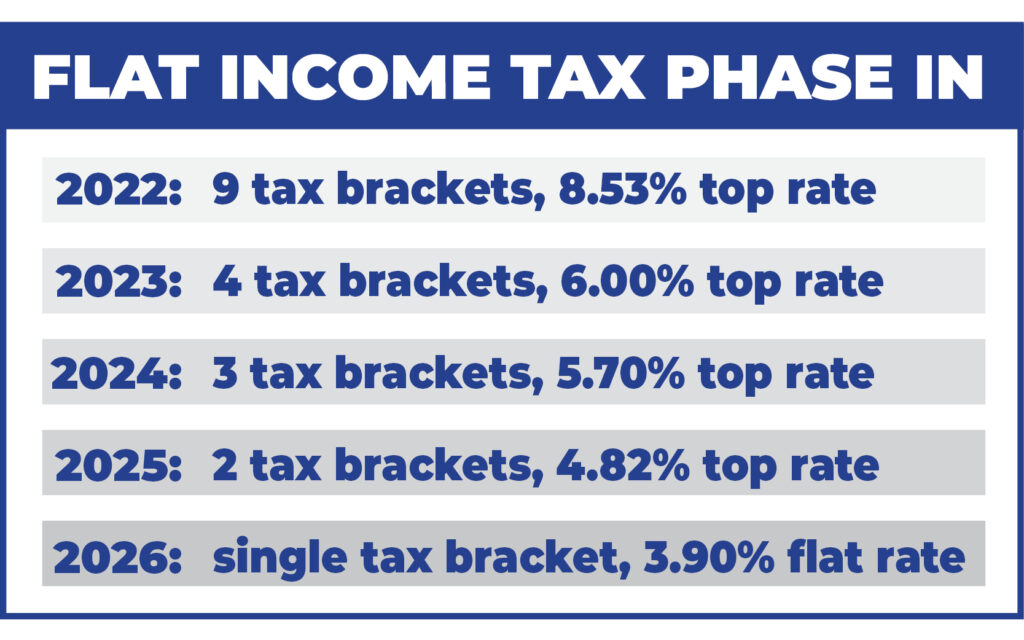This article was published in the National Review.
The Hawkeye State must keep leading the way with pro-growth, pro-family economic policies.
In 2022, Iowa led what has been called a state-level “flat-tax revolution.” The last few years have been historic for state-based tax reform, with the Tax Foundation reporting that 43 states passed some form of tax reform in 2021 or 2022. In 2023, many states are continuing this historic trend. Patrick Gleason, the vice president of state affairs at Americans for Tax Reform, has described this as a “golden era of state tax relief.” Now, Iowa has the opportunity to build on its previous good work in this area by phasing out its income tax.
In February, Governor Kim Reynolds addressed the Cato Institute to share with the nation Iowa’s successful record of advancing pro-family and pro-growth economic policies. This included the universal-school-choice law passed early in this year’s legislative session and the 2022 tax-reform law. The 2022 tax-reform measure is the most significant tax cut in state history. The measure replaces the nine-bracket progressive income tax with a top rate of 8.53 percent, and gradually reduces rates until a flat 3.9 percent rate is established in 2026. The corporate-tax rate is also being lowered following a revenue trigger, until it reaches a flat 5.5 percent.

At Cato, Governor Reynolds told the audience that Iowa is far from finished with tax reform, and said that her goal is to eliminate the income tax altogether. This is a goal that is shared by many in the legislature, including Iowa senate majority leader Jack Whitver, who has been instrumental in helping Governor Reynolds enact pro-growth tax reform. Both the governor and Senator Whitver understand that Iowa cannot be complacent, especially as other states continue to lower their rates. States are in competition with each other for both jobs and people, and increasing worker mobility has made low-tax states more attractive. Iowa knows as much, and is doing all it can to be one of those low-tax states.
Evidence of this was made clear when the Iowa senate introduced a tax-reform measure this session that would have placed the income tax on a path toward elimination. Senator Dan Dawson, who chairs the Ways & Means Committee, is the author of a bill that would build on the tax cuts. Senator Dawson’s bill calls for the individual income tax to be lowered to a flat 4 percent in 2025 and then fall to 3.9 percent in 2026. By 2027, the rate would fall to 2.95 percent, and by 2028 the rate would be lowered to 2.5 percent. The proposal would also speed-up future corporate tax reductions, with the goal of phasing-down the rate to a flat 4.75 percent instead of the current target of 5.5 percent.
Once the 2.5 percent flat rate is implemented, the next stage would be to phase down the individual income tax until it is completely eliminated. Senator Dawson’s plan does this by utilizing the Taxpayer Relief Fund, which he proposes to rename the Individual Income Tax Elimination Fund. The Taxpayer Relief Fund was originally intended for the purpose of providing Iowans with income-tax relief. Currently, the Taxpayer Relief Fund has a $2.7 billion balance, which is expected to increase in Fiscal Year 2024 to $3.5 billion. It is estimated that under this proposal the income tax could be eliminated by 2030 by utilizing the Taxpayer Relief Fund.
A sound tax policy must begin with limiting spending. Governor Reynolds and the legislature have made conservative budgeting a cornerstone of their policy agenda. Iowa is anticipating a $1.7 billion surplus for fiscal year 2023, after a $1.9 billion surplus in fiscal year 2022. The state is forecast to report an estimated $2 billion surplus in fiscal year 2024. This is in addition to Iowa’s reserve funds, which are fully funded at their maximum limit and are projected to increase in future fiscal years.


Governor Reynolds and the legislature continued to practice fiscal conservatism with a 2024 budget of $8.5 billion, which spends only 88.25 percent of estimated revenues. The budget is a slight increase from the previous budget. Further, the legislature passed Governor Reynolds’s state-government-reform measure, which will consolidate agencies to increase government efficiency. Currently, Iowa has 37 executive-branch cabinet agencies — more than any of its neighbors. The governor’s proposal would reduce the number of executive-level agencies to 16. It is estimated that this proposal would save taxpayers over $214 million over four years.
The legislature may not have enacted Senator Dawson’s income-tax-reform bill, but it is all but certain that further income-tax reform will be a top agenda item for the next legislative session in 2024. Iowa’s fiscal foundation is strong as a result of such reform efforts, but there is still more work to be done. The Hawkeye State must keep leading the way in this “golden era of state tax relief.”
